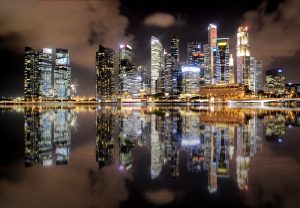Last week, Singapore’s Ministry of Finance released its budget for 2021. Despite controlling the spread of COVID-19 within its own borders, Singapore is heavily reliant on the global flow of people, goods, and capital, and so has been especially hard hit by the pandemic. The economy shrank by a record 5.8 percent in 2020. As bad as that is, it would have been worse had the government not mobilized extensive fiscal resources, tapping its well of accumulated reserves to pump nearly S$100 billion of coronavirus aid into the economy. The question now is where do things go from here as the country tries to pull out of the worst recession in its history and the 2021 budget holds some answers. So what’s in it?
The truth is, nothing ground-breaking. The new budget mostly signals a desire to get the ship back on track without resorting to further deficit-busting fiscal stimulus or drastically changing the market-friendly, pro-business orientation of the economy. It proposes to tweak things at the margins using the favored tools of Singapore’s civil servant technocrats, a combination of rebates, subsidies, credit, and tax schemes that place the business sector front and center in the recovery. In his statement to Parliament, Deputy Prime Minister Heng Swee Keat declared the 2021 budget would get the country moving “from containment to restructuring” by replacing broad-based support with more targeted measures.
One of the first steps is to get the state’s finances back in order. Singapore ran a fiscal deficit of S$64.9 billion last year (the largest in its history), and the Ministry of Finance is looking to pare that down this year to S$11 billion. This will be accomplished through a projected 18.6 percent rise in (primarily tax) revenue as economic conditions improve. The 2021 budget also substantially reduces special transfers, which reached S$53.59 billion in 2020. These special transfers were the main weapon the government brought to bear on the pandemic, about half of which went toward a wage subsidy for employers who kept workers on the payroll.
In the 2021 budget, such special transfers account for only S$4.86 billion, a 90.9 percent reduction. Coupled with the expected increase in revenue, this should close the deficit considerably. The budget also delays a planned hike in the GST consumption tax, as officials no doubt concluded a tax likely to reduce consumption would be ill-advised in these circumstances. The GST, even without the hike, is projected to generate $$11.34 billion for the government this year, and the Ministry expects to increase it in the near future.
In terms of specific measures aimed at reviving the economy and containing the pandemic, the budget blocks out $$11 billion for vaccines and contact tracing, salary enhancements for healthcare workers, wage subsidies and incentives for companies that hire and upskill local workers and the extension of a working capital and trade loan program to ensure businesses have access to credit. Distressed sectors also received lifelines, with the aviation industry getting S$870 million. Direct support for households in the budget is more modest, with S$900 million for a mix of cash vouchers and other rebates to help with everyday expenses like utility bills.
Even the Singapore Green Plan 2030, which lays out a strategy for creating more sustainable economy, calls for a gas tax hike, the elimination of certain fees on electric vehicles and a deepening of the green finance sector to encourage private investment in sustainable projects. All of these steps reflect a fundamental belief in the primacy of market mechanisms, with provisions mainly designed to slightly change incentive structures in order to let the market operate more efficiently and optimize particular policy goals.
In other words, there’s nothing radical or surprising in this budget. If anything, it’s a signal that policymakers expect things to begin normalizing soon. The tools being employed are conventional – subsidies, rebates, taxes – and modest, aimed primarily at shoring up vital sectors like healthcare while relying on the private sector to get the economy moving again. If anyone was expecting this crisis to fundamentally reshape the political economy of Singapore, by leading to radical changes to monetary or fiscal policy, this budget suggests that is not going to be the case.

































